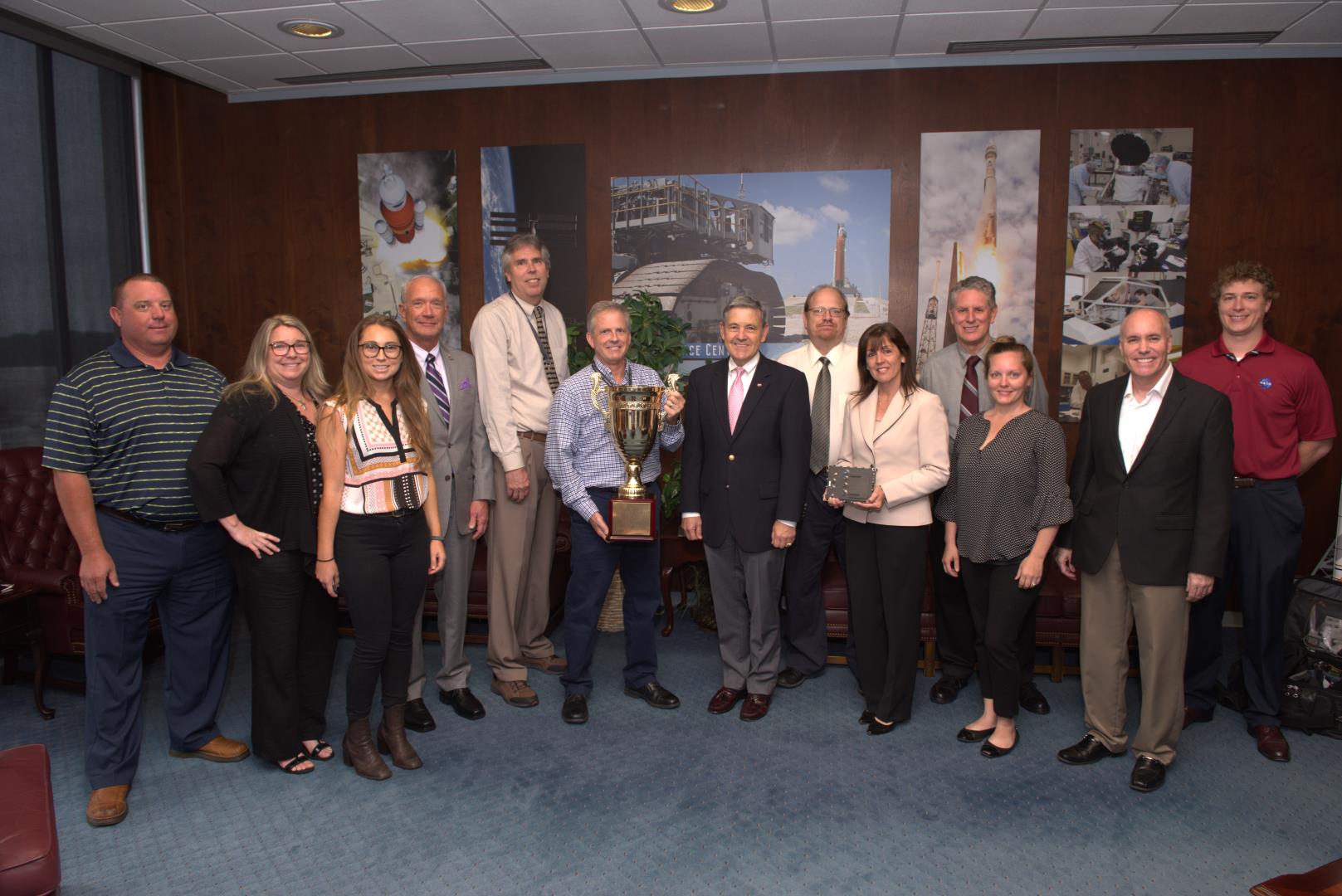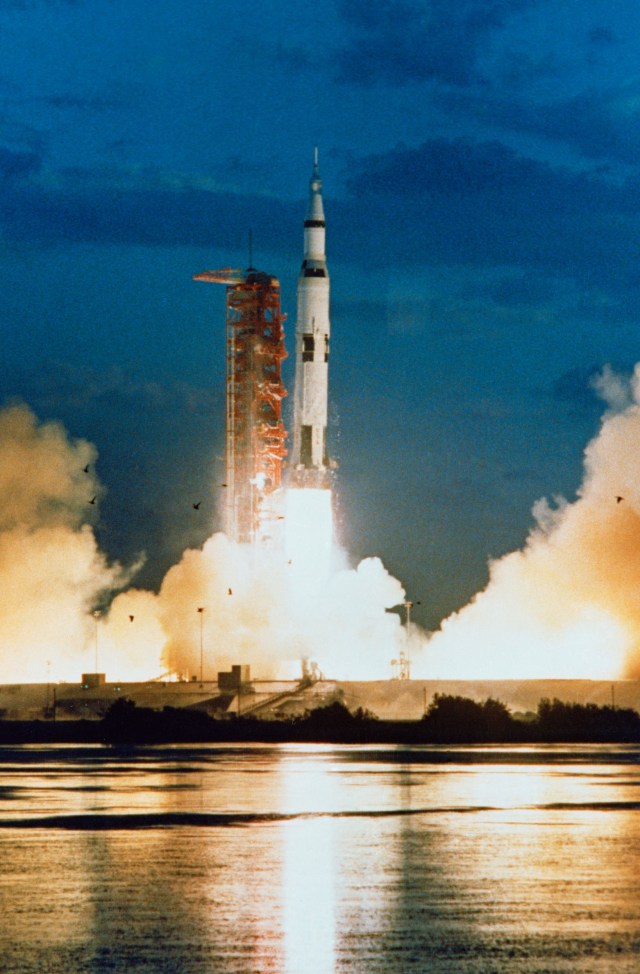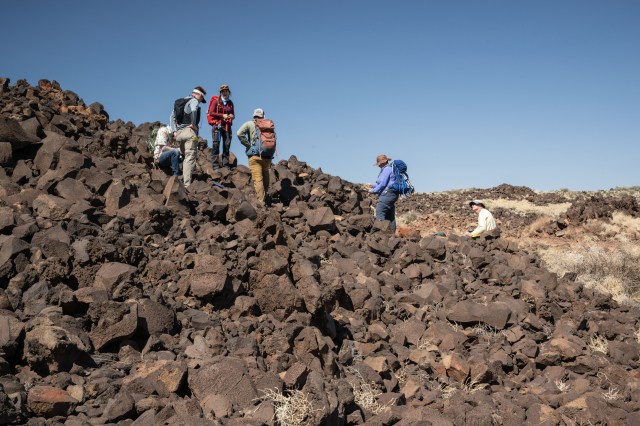
Last year, Kennedy Space Center led NASA technology transfer with the highest number of patent licenses—18. Recently, the center’s Technology Transfer Office was presented with an internal award for the achievement. Daniel Lockney, NASA Headquarters Technology Transfer program executive, presented the team with the trophy via Skype.
Lockney first introduced the internal trophy three years ago as a way to incentivize healthy competition among NASA’s 10 centers for patent licensing. This trophy travels to the winning center for one year at a time, and this year, Kennedy will have it on display, “cementing Kennedy’s place in tech transfer,” said Lockney.
Patent licensing enables outside companies to use technology developed by NASA in commercial products and services that benefit the public. Thanks to the agency’s robust Technology Transfer program, NASA’s innovative solutions are found in hospitals, factories, family rooms and more, where they benefit everyone.
Among the employees recognized were Jim Nichols, Kennedy licensing manager; Jonathan Leahy, Kennedy licensing attorney; Ginger Arrington, licensing paralegal; Jeff Kohler, technology transfer specialist; Lewis Parrish, senior technology transfer specialist; and Kurt Kessel, technology transfer specialist.
Shawn Quinn, director of engineering at Kennedy, also recognized individuals supporting the Autonomous Flight Termination Unit (AFTU) on behalf of Kennedy. The team is part of a joint project among NASA, the U.S. Air Force, the Defense Advanced Research Projects Agency (DARPA), and the Federal Aviation Administration (FAA) slated to receive the Federal Laboratory Consortium (FLC) for Technology Transfer 2019 Interagency Partnership Award on April 24 at the FLC national meeting in Orlando.
Lisa Valencia, project manager of the Autonomous Flight Termination System in the Engineering Directorate; Lewis Parrish, senior technology transfer specialist; Erik Magnuson, AFTU systems engineer; Roger Zoerner, AFTU software engineer, and many others on the team worked on the development and transfer of this technology.
According to the FLC, the award recognizes these agencies for “collaboratively accomplishing outstanding work in the process of transferring a technology.” The FLC represents over 300 federal laboratories, and the AFTU competed with multiple nominations across the U.S. government for this award, resulting in Kennedy being the only NASA center to win a FLC award this year. The FLC stated that the AFTU’s nomination was “truly of the highest caliber.”
The AFTU is a subsystem that allows the rocket it is flown on to independently determine if it is off course and self-destruct if it discovers this is the case. “This system eliminates the need for ground personnel, transmitters, telemetry receivers and radars historically used for monitoring rocket launches and commanding launch vehicle destruction when a rocket goes off course,” said Parrish.
Quinn spoke on the significance of this technology, stating “The AFTU is not only an important endeavor for NASA to make launch operations safer and more efficient from a time and cost perspective, but through the transfer of this enabling technology, it also has a multiplier effect across the entire space industry.”
Both the AFTU hardware and software were developed by the technical team at Kennedy led by Valencia. This team worked closely with the Air Force to develop the Core Autonomous Safety Software (CASS), which is the software that provides the rules and restrictions that enables the launch vehicle to make destruction decisions and, thus, is flown on any vehicle using AFTU technology. DARPA, another key agency in the development of this project, provided the necessary funding and launch opportunities for the development and testing of this CASS software and AFTU technology. Additionally, the FAA assisted with writing and approving NASA AFTU requirements for design, testing and operation.
One flight test of this technology was enabled by NASA’s Flight Opportunities program, which aims to provide access to space-related test environments through the use of four types of flight platforms as a way to demonstrate technical readiness. Through this program, two AFTUs were flown on UP Aerospace’s SpaceLoft (SL)-12 mission, and another test is scheduled for the SL-14 mission.
Parrish’s role in the process was to lead the technology transfer aspect of this project and provide transfer support to Valencia’s office, including software release review and approval, vetting companies requesting to receive the AFTU design package, working with export control, and completing technology transfer and software usage agreements. In addition, Parrish marketed the technology to emerging commercial space companies, further expanding awareness that ultimately led to transferring the technology to outside companies.
The AFTU technology currently has been transferred to 35 recipients, including commercial space companies and Department of Defense agencies, and will be fully operational by summer. The team at Kennedy is making available the reference design drawings and generic wrapper software that will allow custom implementation by each partner. Rocket Lab will be the first company to use the AFTU as is, while other companies, such as SpaceX, have already started using the software derived from this technology. Parrish continues to actively work on this project. “Being able to help move NASA-developed technologies out of the laboratories and into use by the public is the most gratifying aspect of my job,” said Parrish.
“Every time I hit that ‘send’ icon to transfer those design files, that technology benefits yet another customer who can utilize it for safer, more affordable launches of their rockets and payloads,” he said. “My hope is that the awareness of this technology will continue to grow across the space industry.”
While receiving the FLC’s Interagency Partnership Award acknowledges Kennedy’s capabilities in developing cutting-edge technology, the sheer number of patent licenses put out by the center’s Technology Transfer Office demonstrates research and technology advancements made at the multi-user spaceport supports U.S. economic competitiveness and enables NASA’s exploration missions.



































